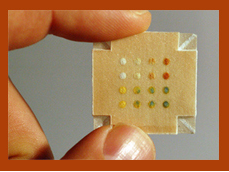The implications for public health, particularly in poor developing countries, are, of course, enormous. This also has the potential to be a game-changer across the board, putting a “lab” in every doctor — or community health worker’s — pocket, dramatically reducing the time and cost of tests. Imagine: health-care costs that go down. (Although, as my colleague Ed Jezierski at InSTEDD points out, if it turns out that proprietary component of the test is expensive, the bargain disappears.)
The Wired story was grouped on TrackerNews with a Technology Review article providing a more detailed explanation of the imaging system (which can also be used for testing water):
The counter has high throughput–while it’s capable of detecting small numbers of cells, it can image as many as 100,000 cells in a 20-centimeter-squared field of view in one second. The counter can, for example, determine the concentration of red blood cells in an unprocessed blood sample with 90 percent accuracy. Red blood cell count can be used to diagnose anemia, to monitor malaria, and to monitor patients’ responses to chemotherapy.
If you haven’t got cell phone handy, George Whitesides at Harvard can whip up a diagnostic chip out of paper and tape. It turns to be surprisingly easy to create channels on the stamp-size pieces of paper to control the flow of sample fluid — a drop of blood, for example. By creating layers separated by tape, a single chip can be used for multiple tests. The results appear as tiny dots of color that can be easily and quickly analyzed, much like a pregnancy test.
Whitesides’ nonprofit, Diagnostics for All, which was created to scale up and commercialize the concept, won both the 2008 Harvard Business School Social Enterprise Business Plan Contest and the MIT $100K Entrepreneurship Competition, so is further along the tech transfer trail than most.
Both the the phone and the paper chip are designed to test for known pathogens. But what about the new ones that keep popping up, such as SARS, or those expanding into new regions, such as West Nile virus in the U.S., or chikungunya in Italy? Ian Lipkin’s team at Columbia University have developed GreeneChips, glass slides with “over 30,000 pieces of genetic material, representing thousands of different pathogens. which can test for almost all known viruses, bacteria, fungi, or parasites,” and Mass Tag PCR, a “multiplex platform that allows epidemiologists and doctors to simultaneously test one sample for the presence of up to 30 different agents.” When a faced with a novel pathogen, the tests can quickly determine what its closest relatives are, which, in turn jumpstart the investigation as to whether it is a vector-borne, air-borne, food-borne or water-borne disease. Although Mass Tag PCR is provided free to WHO Network partners, these are still pretty boutique technologies.
But who knows? A Greene paper chip or a Mass Tag cell phone could be just around the corner….










